Figure 1:Features of Java 8
JAVA 8 is one of the major feature releases of “JAVA programming language” development. It is one of the revolutionary releases of the development of software platforms. The initial version of Java 8 was released on 18 March 2014. It is responsible for upgrading Java programming, tools, JVM, and libraries. Through its release, Java offers support for functional programming, new streaming API, new APIs for date time manipulation, and others.
Why Java 8?
The newest version of the Java platform has revolutionized the IT industry with its improvements. Although, many companies prefer stability over trendiness 64% of the industry is persuading for degradation. There are certain reasons behind it:
It is faster– Applications moving towards Java 8 have seen certain improvements in speed without any particular work or tuning.
Garbage Collector Improvements – Generally, “Java Performance” is related to “Garbage Collection” and it is sure that poor performance of garbage collection can impact the performance of the application. Thus, Java 8 has made substantial improvements to Garbage Collection with the introduction of MetaSpace.
Join Speed Improvements– The join speed improvement is the latest framework of Java 8 which covers parallel operations in Stream API.
Enhancements in Java 8
Java 8 provides certain enhancements in programming through its newly added features:
- Lambda Expressions
- Functional Interface
- Optional Class
- Method References
- ForEach() method
- String Joiner
- Stream API
- Collectors Class
Lambda Expressions:
This feature helps implement the interface (by using an expression) with a functional interface. It is responsible for saving a lot of code and improving code functionality. For lambda expressions, we are not required to define the method every time for its implementation. Rather, we need to just write the code required for performance. Thus, Lambda Expressions (->) in Java are treated as a “Function”. So, a compiler does not need to create a “.class file”.
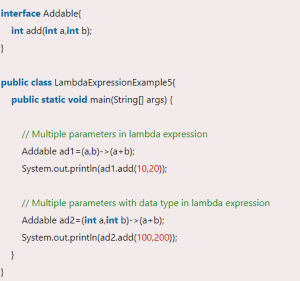
Figure 2:Lambda Expression Example
Functional Interface:
A functional interface is an interface that includes only one “Abstract” method, for example, the “Service” class. However, with this feature, we have the option to have more than one “static” as well as “default” methods which were not initially present in other features of Java. It is annotated with “@FunctionalInterface”.
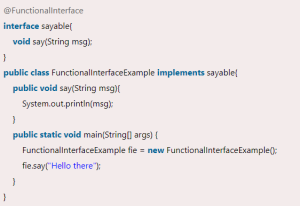
Figure 3:Functional Interface Example
Optional Class:
In Java 8 feature a new class “Optional” has been added. This feature is a public final class. The main task of this class is to handle the “Null Pointer Exception”. For using this class, a programmer is required to import the “java.util package”.This is helpful for the methods to check the existence of a value for a specific variable. Now, here the question arrives “What is a Null Pointer Exception?”. It is nothing but an object or a variable that has not been “instantiated”.If a developer is trying to get a particular value, for that it will throw this kind of exception.
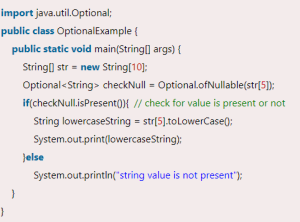
Figure 4:Optional Class Example
In the above example, the output will be “String value is not present”.
Method References:
This feature in Java 8 is responsible for referring to the method of functional interface. It is easy as well as more compact than lambda expressions. In case, developers are referring to any lambda method for reference, it can be replaced by method references.
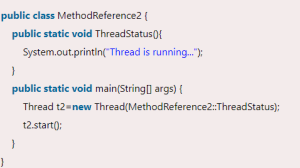
Figure 5:Method References Example
ForEach() Method:
In Java 8, ForEach() method is a new method introduced by Oracle for iterating the elements. This method is responsible for taking a single parameter that is a “functional interface”.It is also a default method defined in “Iterable Interface”.
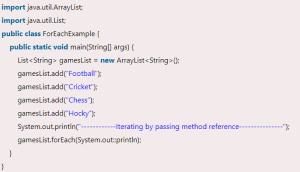
Figure 6:ForEach() Method Example
String Joiner:
The new feature added in Java is String Joiner. This is a final class present in the “java.util package”. This feature is responsible for constructing a chain of characters that is separated by a “Delimiter” like a comma or “,”, hyphen or “-” and others. In the below image, the string joiner will produce the output “Rahul, Raju, Peter, Raheem”.All the names will be printed delimited by a comma.
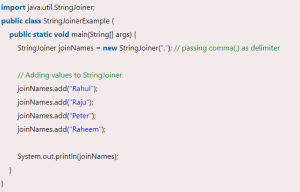
Figure 7:String Joiner Example
Stream API:
This feature is present in the “java.util.stream package” consisting of “classes”, “enums” and “interfaces”.Such a feature in Java is responsible for allowing a functional style of operations on its elements. Moreover, it performs lazy computation and executes whenever it is required.

Figure 8:Stream API Example
Collectors Class:
The newest feature of Java 8 is the Collectors class. It is a final class that extends the object class. This feature is responsible for reducing operations like gathering elements into the collection, encapsulating elements as per the criteria, and others.
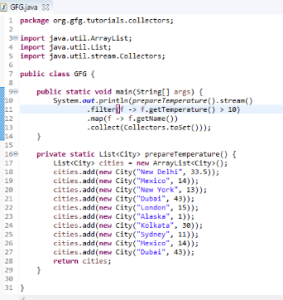
Figure 9:Collectors Class Example
Advantages of Java 8
- It qualifies the “Internet Of Things” making embedded products a scalable, secure, and flexible development platform.
- It offers less code thereby, increasing productivity. Lambda expressions are responsible for simplifying the code for the developers making it compact and easier.
- Modernization of the Java language as well as Java libraries reducing time complexity.
- Developers are now able to build embedded applications with the new compact profiles present in Java 8.
 End to End Technology Solutions
End to End Technology Solutions
